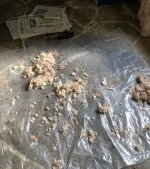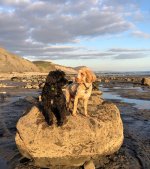A bit random, all this! As an aside I have a load of fluff from my winter use of the tumble dryer going begging and wondered if it would be suitable to put out for nesting, or do you think it would be dangerous?
The last couple of weeks have been sunnier and warmer here and it is really noticeable that the bees are around again, particularly on a large camellia. We also have some blossom out (and I read some organisation is trying to promote 'blossom time' in UK towns, a bit like the cherry blossom time in Japan) on some fruit trees, almond, apricot, peach and plum. However, its not the worker bees I have noticed so much, but what I think must be drones. They keep hanging about a bench we have outside, south facing, and the bees are on it, on me on it, and on the house wall. Although I used to be a beekeeper, I realise I have no idea what the drones do whilst they are waiting for the queen to make her mating flight!
I am also noticing what I think are moth chrysalis' - would this be right, for the time of year? There are a couple of whitish/silvery ones attached to a white wall, which haven't moved for almost a week, although I need to go and check they are still there.


